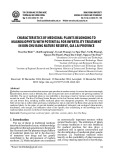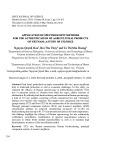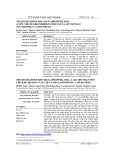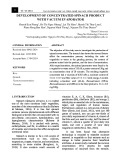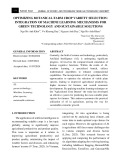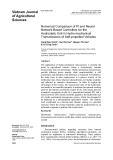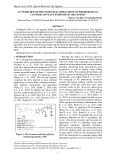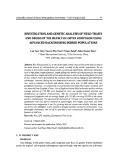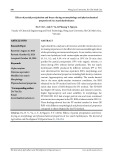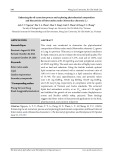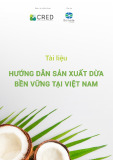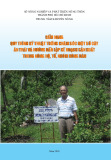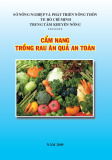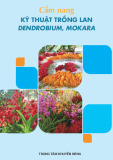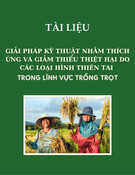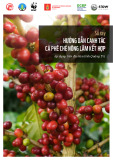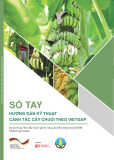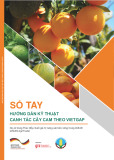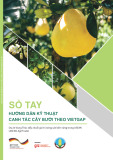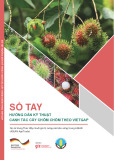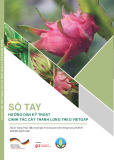
Nong Lam University, Ho Chi Minh City 1
The Journal of Agriculture and Development 23(6) www.jad.hcmuaf.edu.vn
Effects of 6-benziladenine, thidiazuron, and 1-naphthaleneacetic acid on the in vitro callus
formation and shoot multiplication from leaves of Mai vang (Ochna integerrima) HD01 line
Kiet C. Nguyen*, Duy M. Pham, Van H. Phan, Tri M. Bui, & Hau T. Le
Faculty of Agronomy, Nong Lam University, Ho Chi Minh City, Vietnam
ARTICLE INFO ABSTRACT
Research Paper
Received: November 01, 2023
Revised: December 29, 2023
Accepted: January 04, 2024
Keywords
Callus
In vitro
Mai vang
Ochna integerrima
Plant growth regulator
*Corresponding author
Nguyen Cao Kiet
Email:
kiet.nguyencao@hcmuaf.edu.vn
Mai vang (Ochna integerrima (Lour.) Merr.) not only is a popular
ornamental plant but also possesses numerous valuable herbal
properties. An exceptional line, the HD01, was bred by adept
florists at the Binh Loi Mai village, Ho Chi Minh City. The objective
of this research was to determine the optimal 6-benziladenine
(BA), thidiazuron (TDZ) and 1-naphthaleneacetic acid (NAA)
concentrations appropriate for callus formation from leaf samples
and regeneration of shoots from callus of the HD01 line in in vitro
condition. The study including two experiments was arranged
in a completely randomized design with two factors. For callus
induction, the culture medium supplemented with concentrations
of TDZ combined with concentrations of NAA was used, while to
induce shoots, concentrations of BA combined with concentrations
of NAA were added to the medium. The results indicated that 0.2
mg/L TDZ combined with 0.25 mg/L NAA on the base of MS
(Murashige and Skoog) medium supplemented with 7 g/L agar and
30 g/L sugar gave 100% callus formation rate after 17.6 days, with
the largest callus diameter (2.7 cm) and highest callus mass (2.4 g)
after 60 days of culture. The leaf-derived callus produced the best
results when cultured on MS medium supplemented with 7 g/L
agar, 30 g/L sugar, and a combination of 1 mg/L BA and 0.25 mg/L
NAA, forming shoot clusters with the height of 2.2 cm, an average
of 8.5 shoots per cluster and 9.7 leaves per cluster after 60 days of
culture. Based on these results, a preliminary protocol for Mai vang
HD01 micropropagation was established.
Cited as: Nguyen, K. C., Pham, D. M., Phan, V. H., Bui, T. M., & Le, H. T. (2024). Effects of
6-benziladenine, thidiazuron, and 1-naphthaleneacetic acid on the in vitro callus formation and
shoot multiplication from leaves of Mai vang (Ochna integerrima) HD01 line. The Journal of
Agriculture and Development 23(6), 1-12.

2 Nong Lam University, Ho Chi Minh City
The Journal of Agriculture and Development 23(6) www.jad.hcmuaf.edu.vn
1. Introduction
The Mai vang tree (Ochna integerrima) is an
important ornamental plant in Vietnam. Native
to the South East Asia region, the plant is seen
as a symbol for the Lunar New Year due to the
flowering time usually falling in the holiday.
Therefore, O. integerrima has become one of the
most widely cultivated and traded ornamental
plants during the Lunar New Year. Many elite
lines and varieties are produced by breeders and
growers every year, each with particular superior
traits. Among them, the HD01 line selected at
Huu Duc mai garden in Binh Loi Mai village
has many outstanding characteristics, such as
large flower diameter (up to 4 - 6 cm), extended
flowering period, and darker petal and stamen
color than other lines.
In conventional cultivation, O. integerrima is
propagated mainly bzy seeds. However, genetic
variation makes it difficult to create uniform
seedlings, and sometimes the daughter plants
no longer retain the value of the parents. Clonal
propagation methods such as cutting, air-layering
or grafting are also frequently employed for O.
integerrima, but with low multiplication rates and
efficiencies. In vitro propagation techniques have
the advantage of high propagation rates as well
as high uniformity of seedlings, so it has been
applied to propagate many plant species with
different economic values (Tran, 2005). There
have been a few studies on in vitro propagation
of O. integerrima both domestically and
internationally, but few have managed to employ
cell dedifferentiation and callus formation from
leaves to create high propagation rates and
utilize the more abundant starting materials.
Furthermore, although there has been some
success in in vitro propagation of O. integerrima,
the protocols need adjustment, optimizing the
mineral contents and plant growth regulators
depending on each particular variety or line.
Among the plant growth regulators, auxin
and cytokinin play an important role in plant
in vitro morphogenesis, including callus, shoot
and root formation. 6-benziladenine (BA),
thidiazuron (TDZ) and 1-naphthaleneacetic
acid (NAA) are common plant growth regulators
frequently employed in micropropagation. The
combinations of types and concentrations of these
plant growth regulators are usually the deciding
factor in the morphogenesis and regeneration of
plant cell in vitro, particularly for O. integerrima.
Each stage of micropropagation may require very
different and specific combinations (Ho et al.,
2019). Therefore, the objective of this study was
to determine the most appropriate combination
for establishing the calluses from leaves of the
HD01 line and regeneration of these calluses to
shoot clusters.
2. Materials and Methods
2.1. Time and place of the study
The study was carried out from March to July
2023, at the tissue culture lab of the Department
of Physiology and Biochemistry, Faculty of
Agronomy, Nong Lam University, Ho Chi Minh
City, Vietnam.
2.2. Experimental design
2.2.1. Experiment 1: Effects of TDZ and NAA
concentrations on the induction of callus
formation from O. integerrima leaf samples
Experiment 1 had two factors: factor T (TDZ
concentration): 0.1 mg/L; 0.2 mg/L; 0.3 mg/L; 0.4
mg/L, and factor N (NAA concentration): 0 mg/L;
0.25 mg/L; 0.5 mg/L. The experiment consisted of
12 treatments with 3 replications and arranged in
a completely randomized design. Each replicate
had 5 flasks. Each flask had 3 samples.

Nong Lam University, Ho Chi Minh City 3
The Journal of Agriculture and Development 23(6) www.jad.hcmuaf.edu.vn
2.2.2. Experiment 2: Effects of BA and NAA
concentrations on shoot regeneration from
callus of O. integerrima
Experiment 2 had two factors: factor B (BA
concentration): 0 mg/L; 1 mg/L; 2 mg/L; 3 mg/L,
and factor N (NAA concentration): 0 mg/L; 0.25
mg/L; 0.5 mg/L. The experiment consisted of 12
treatments with 3 replications and arranged in
a completely randomized design. Each replicate
had 5 flasks. Each flask had 3 samples.
2.3. Experimental method
The base medium in both experiments was
Murashige and Skoog (MS) supplemented with
7 g/L agar, 30 g/L sucrose, and plant growth
regulators according to treatments.
In experiment 1, leaves of 8 - 10 cm in length
and 4 - 5 cm in width were disinfected with sodium
hypochlorite (made in Vietnam) for 20 min and
rinsed 3 times with sterilized water. The undamaged
sections of the leaves with veins were then cut into
1 × 1 cm and put in the flasks face-down on the
medium and kept in the dark for 60 days.
In experiment 2, calluses were produced
in large quantity following the best treatment
in experiment 1. After 60 days in the dark, the
calluses were then put under light (2500 ± 500
lux) for another 10 days. Green, compact and
dry calluses were selected, and small samples of
these calluses with the diameter of 0.5 cm were
dissected and used as starting materials to be
transplanted into the flasks for experiment 2. The
calluses were grown for 60 days.
2.4. Parameters
2.4.1. Experiment 1
The samples were monitored every day and
the day of first callus formation was recorded
for each treatment. Colors of the calluses were
recorded every 10 days, and the calluses were
considered dead when they turned dark brown.
On day 60 of culture, the largest diameters (cm)
and fresh weights (mg) of 10 random samples
were measured. The callus formation rate (%)
in each treatment on day 60 was calculated as
the number of samples that successfully formed
calluses divided by the total number of samples
(45). Samples were considered successfully
forming callus when undifferentiated, white or
yellowish/yellow cell clusters could be observed
on the leaf samples.
2.4.2. Experiment 2
The number of shoots and number of leaves
per cluster and the height of each shoot cluster
(cm) were recorded through the glass layer of the
flask every 10 days. Time of shoot formation was
defined as the day when more than 50% of the
samples formed shoot buds in each treatment.
Fresh weights of shoot clusters (mg) were
recorded on day 60.
2.5. Data processing and analyses
Data were processed with Excel 2010
(Microsoft, USA). R (version 4.2.3) was used
to perform ANOVA and rank the treatments
with Duncan’s multiple range test at a = 0.01 or
a = 0.05. Data on the rate of callus formation
in experiment 1 were transformed using the
formula before statistical analysis, the value 0
replaced with 1/4 n and 100 replaced with 100
- 1/4 n (with n = 15 samples) before the formula
was applied. Data on the diameter of callus in
experiment 1, number of shoots, shoot cluster
height and number of leaves in experiment 2 were
transformed using the formula before statistical
analysis (Ngo et al., 2013).

4 Nong Lam University, Ho Chi Minh City
The Journal of Agriculture and Development 23(6) www.jad.hcmuaf.edu.vn
3. Results and Discussion
3.1. Effect of TDZ and NAA concentrations on the induction of callus from leaf samples of O.
integerrima
3.1.1. Effect of TDZ and NAA concentrations on the rate and time of callus formation
Table 1. Effect of thidiazuron (TDZ) and 1-naphthaleneacetic acid (NAA) concentrations on the rate
(%) and time (days) of callus formation from leaf samples of O. integerrima HD01
TDZ concentration
(mg/L)
NAA concentration (mg/L) Average (T)
0 0.25 0.5
Rate of callus
formation
(%)
0.1 0 100 93.3 64.4
0.2 0 100 84.4 61.5
0.3 0 100 84.4 61.5
0.4 0 100 82.2 60.7
Average (N) 0c 100a86.1b
CV (%) = 17.4%; FT = 0.3ns ; FN = 299.2**; FT*N = 0.3ns
Time of callus
formation
(days)
0.1 - 18.2 17.8 -
0.2 - 17.6 17.9 -
0.3 - 17.7 17.8 -
0.4 - 18.1 18.3 -
Average (N) - 17.9 18.0 -
Within the same group, the same letter following the means represents statistically insignificant difference. ns:
statistically insignificant difference; **: significant difference at P ≤ 0.01.
Figure 1. Callus samples of the treatments after 60 days of culture. T1-4: thidiazuron concentration
of 0.1, 0.2, 0.3 or 0.4 mg/L, respectively; N1-3: 1-naphthaleneacetic acid concentration of 0, 0.25 or
0.5 mg/L, respectively.

Nong Lam University, Ho Chi Minh City 5
The Journal of Agriculture and Development 23(6) www.jad.hcmuaf.edu.vn
high rates of callus formation in some in vitro
plants (Verma, 2016; Karakas, 2020). The data of
this experiment show similar results. Depending
on the type of plants, the most appropriate ratio
of TDZ and NAA for callus formation may differ
(Lu et al., 2023).
Callus formation time in the treatments
ranged from 17.6 days to 18.3 days. In particular,
the treatment supplemented with 0.2 mg/L TDZ
combined with 0.25 mg/L NAA gave the fastest
callus formation time (17.6 days). However, no
statistically significant differences were found.
On day 60, the results of Table 1 shows that
the TDZ concentration had no effect on the
rate of callus formation. However, the NAA
concentration significantly affected the rate of
callus formation (Figure 1). In particular, the
concentration of 0.25 mg/L NAA gave the best
result, achieving 100% callus formation rate,
significantly higher than the rates of the remaining
concentrations. Considering the interaction
between TDZ and NAA concentrations, the rate
of callus formation was not statistically different,
ranging from 82.2% to 100%. The combination
of TDZ and NAA has been reported to result in
3.1.2. Effect of TDZ and NAA concentrations on color of callus during culture period
Table 2. Effect of thidiazuron (TDZ) and 1-naphthaleneacetic acid (NAA) concentrations on color of
callus from leaf samples of O. integerrima HD01
TDZ concentration (mg/L) NAA concentration (mg/L)
0 0.25 0.5
Day 20
0.1 - Light yellow Light yellow
0.2 - Light yellow Light yellow
0.3 - Light yellow Light yellow
0.4 - Light yellow Light yellow
Day 30
0.1 - Light yellow Light yellow
0.2 - Light yellow Light yellow
0.3 - Light yellow Light yellow
0.4 - Light yellow Light yellow
Day 40
0.1 - Ye l l o w Dark yellow
0.2 - Ye l l o w Dark yellow
0.3 - Ye l l o w Dark yellow
0.4 - Ye l l o w Dark yellow
Day 50
0.1 - Ye l l o w Dark yellow
0.2 - Ye l l o w Dark yellow
0.3 - Ye l l o w Dark yellow
0.4 - Dark yellow Dark yellow
Day 60
0.1 - Dark yellow Yellow-brown
0.2 - Ye l l o w Golden brown
0.3 - Ye l l o w Pale brown
0.4 - Yellow-brown Brown

